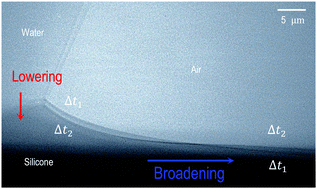当前位置:
X-MOL 学术
›
Soft Matter
›
论文详情
Our official English website, www.x-mol.net, welcomes your
feedback! (Note: you will need to create a separate account there.)
Self-spreading of the wetting ridge during stick-slip on a viscoelastic surface
Soft Matter ( IF 2.9 ) Pub Date : 2017-10-23 00:00:00 , DOI: 10.1039/c7sm01408b S. J. Park 1, 2, 3, 4, 5 , J. B. Bostwick 6, 7, 8, 9 , V. De Andrade 9, 10, 11, 12, 13 , J. H. Je 1, 2, 3, 4, 5
Soft Matter ( IF 2.9 ) Pub Date : 2017-10-23 00:00:00 , DOI: 10.1039/c7sm01408b S. J. Park 1, 2, 3, 4, 5 , J. B. Bostwick 6, 7, 8, 9 , V. De Andrade 9, 10, 11, 12, 13 , J. H. Je 1, 2, 3, 4, 5
Affiliation

|
Dynamic wetting behaviors on soft solids are important to interpret complex biological processes from cell–substrate interactions. Despite intensive research studies over the past half-century, the underlying mechanisms of spreading behaviors are not clearly understood. The most interesting feature of wetting on soft matter is the formation of a “wetting ridge”, a surface deformation by a competition between elasticity and capillarity. Dynamics of the wetting ridge formed at the three-phase contact line underlies the dynamic wetting behaviors, but remains largely unexplored mostly due to limitations in indirect observation. Here, we directly visualize wetting ridge dynamics during continuous- and stick-slip motions on a viscoelastic surface using X-ray microscopy. Strikingly, we discover that the ridge spreads spontaneously during stick and triggers contact line depinning (stick-to-slip transition) by changing the ridge geometry which weakens the contact line pinning. Finally, we clarify ‘viscoelastic-braking’, ‘stick-slipping’, and ‘stick-breaking’ spreading behaviors through the ridge dynamics. In stick-breaking, no ridge-spreading occurs and contact line pinning (hysteresis) is enhanced by cusp-bending while preserving a microscopic equilibrium at the ridge tip. We have furthered the understanding of spreading behaviors on soft solids and demonstrated the value of X-ray microscopy in elucidating various dynamic wetting behaviors on soft solids as well as puzzling biological issues.
中文翻译:

粘弹性表面上粘滑过程中润湿脊的自蔓延
在软固体上的动态润湿行为对于从细胞-底物相互作用解释复杂的生物过程非常重要。尽管在过去的半个世纪中进行了深入的研究,但尚未清楚了解传播行为的潜在机制。在软物质上润湿的最有趣的特征是形成“润湿脊”,即由于弹性和毛细作用之间的竞争而导致的表面变形。在三相接触线处形成的润湿脊的动力学是动力学润湿行为的基础,但是由于间接观察的局限性,很大程度上仍未进行探索。在这里,我们使用X射线显微镜直接观察在粘弹性表面上连续和粘滑运动期间的润湿脊动态。惊人地 我们发现,隆起在粘着期间自发扩散,并通过改变隆起的几何形状来触发接触线钉扎(黏着到滑移过渡),从而削弱了接触线的钉扎。最后,我们通过山脊动力学阐明了“粘弹性制动”,“粘滑”和“粘破”扩散行为。在断棍过程中,不会发生脊扩散,并且在保持脊尖端的微观平衡的同时,通过尖弯可以增强接触线钉扎(滞后)。我们进一步了解了在软固体上的扩散行为,并证明了X射线显微镜在阐明各种在软固体上的动态润湿行为以及令人费解的生物学问题方面的价值。我们通过山脊动力学阐明了“粘弹性制动”,“粘滑”和“粘破”扩散行为。在断棍过程中,不会发生脊扩散,并且在保持脊尖端的微观平衡的同时,通过尖弯可以增强接触线钉扎(滞后)。我们进一步了解了在软固体上的扩散行为,并证明了X射线显微镜在阐明各种在软固体上的动态润湿行为以及令人费解的生物学问题方面的价值。我们通过山脊动力学阐明了“粘弹性制动”,“粘滑”和“粘破”扩散行为。在断棍过程中,不会发生脊扩散,并且在保持脊尖端的微观平衡的同时,通过尖弯可以增强接触线钉扎(滞后)。我们进一步了解了在软固体上的扩散行为,并证明了X射线显微镜在阐明各种在软固体上的动态润湿行为以及令人费解的生物学问题方面的价值。
更新日期:2017-11-15
中文翻译:

粘弹性表面上粘滑过程中润湿脊的自蔓延
在软固体上的动态润湿行为对于从细胞-底物相互作用解释复杂的生物过程非常重要。尽管在过去的半个世纪中进行了深入的研究,但尚未清楚了解传播行为的潜在机制。在软物质上润湿的最有趣的特征是形成“润湿脊”,即由于弹性和毛细作用之间的竞争而导致的表面变形。在三相接触线处形成的润湿脊的动力学是动力学润湿行为的基础,但是由于间接观察的局限性,很大程度上仍未进行探索。在这里,我们使用X射线显微镜直接观察在粘弹性表面上连续和粘滑运动期间的润湿脊动态。惊人地 我们发现,隆起在粘着期间自发扩散,并通过改变隆起的几何形状来触发接触线钉扎(黏着到滑移过渡),从而削弱了接触线的钉扎。最后,我们通过山脊动力学阐明了“粘弹性制动”,“粘滑”和“粘破”扩散行为。在断棍过程中,不会发生脊扩散,并且在保持脊尖端的微观平衡的同时,通过尖弯可以增强接触线钉扎(滞后)。我们进一步了解了在软固体上的扩散行为,并证明了X射线显微镜在阐明各种在软固体上的动态润湿行为以及令人费解的生物学问题方面的价值。我们通过山脊动力学阐明了“粘弹性制动”,“粘滑”和“粘破”扩散行为。在断棍过程中,不会发生脊扩散,并且在保持脊尖端的微观平衡的同时,通过尖弯可以增强接触线钉扎(滞后)。我们进一步了解了在软固体上的扩散行为,并证明了X射线显微镜在阐明各种在软固体上的动态润湿行为以及令人费解的生物学问题方面的价值。我们通过山脊动力学阐明了“粘弹性制动”,“粘滑”和“粘破”扩散行为。在断棍过程中,不会发生脊扩散,并且在保持脊尖端的微观平衡的同时,通过尖弯可以增强接触线钉扎(滞后)。我们进一步了解了在软固体上的扩散行为,并证明了X射线显微镜在阐明各种在软固体上的动态润湿行为以及令人费解的生物学问题方面的价值。











































 京公网安备 11010802027423号
京公网安备 11010802027423号